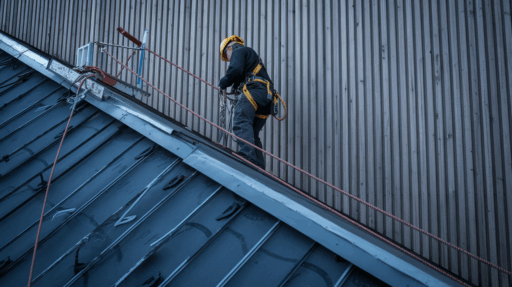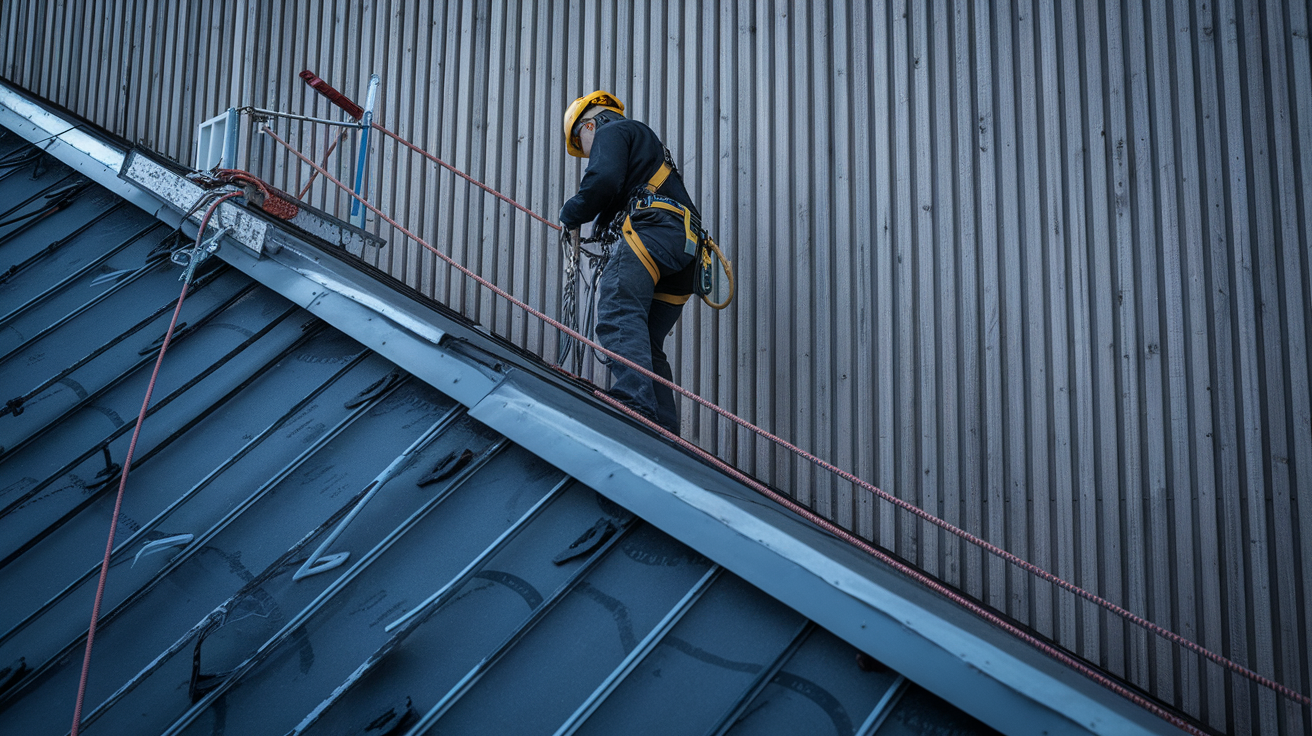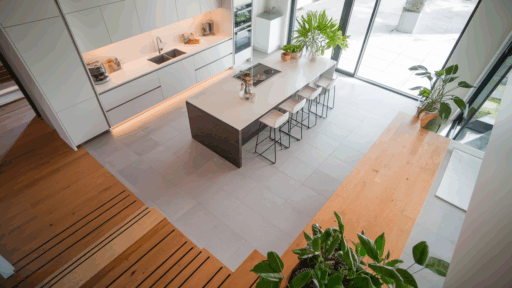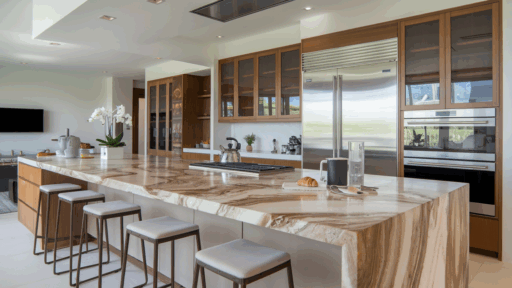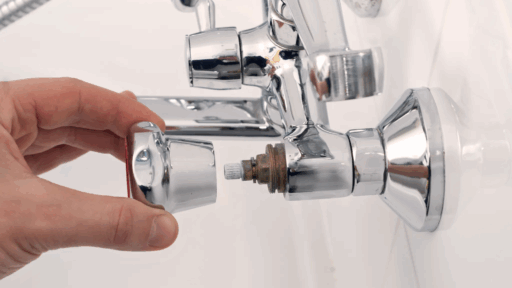When my roof started to show signs of wear, shingles curling, dark streaks forming, and water spots appearing inside, I knew it was time for a replacement.
However, what surprised me the most was the significant variation in cost.
I had no idea that factors such as roof pitch, material choice, and even my zip code could impact the final bill.
If you’re in the same boat and wondering, “How much will a new roof cost?” then this guide is for you.
Below, I’ll walk you through every factor that affects roof pricing, from materials and labor to hidden extras and regional differences.
I’ll also share what I learned during my own experience to help you avoid surprises and budget more confidently.
What Is the Average Cost of a New Roof?
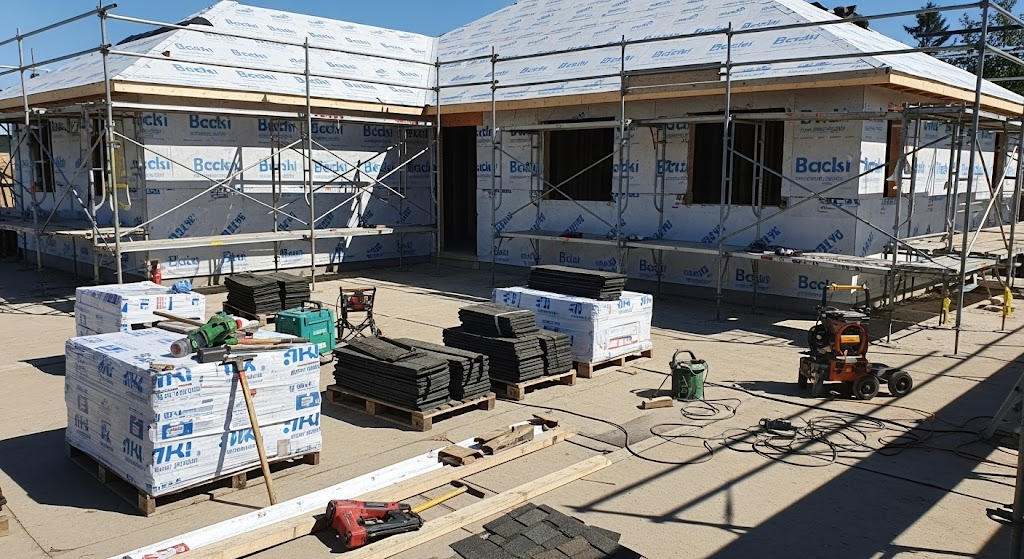
The average cost of a new roof in the U.S. is about $30,680 for a 3,000-square-foot architectural asphalt shingle roof.
This includes tear-off, underlayment, flashing, vents, shingles, and cleanup.
Actual costs vary by location, roof design, materials, and contractor rates.
In mid-cost areas, prices typically range from around $24,500, while in high-cost zones, they can exceed $35,000.
Smaller homes or basic 3-tab shingles may range from $12,000 to $18,000. Premium materials or complex rooflines can push costs over $40,000.
Plan to budget between $6 and $12 per square foot, and always get multiple quotes for the most accurate pricing.
Roof Cost by Material Type
Roofing costs are often measured per square foot or per “square” (100 sq. ft). This helps when comparing materials or estimating totals. Prices vary by material, location, and roof complexity.
| Roofing Material | Average Cost per Sq Ft |
|---|---|
| 3-Tab Asphalt Shingles | $4.00 – $5.50 |
| Architectural Asphalt | $5.50 – $8.00 |
| Luxury Asphalt | $8.00 – $10.00 |
| Metal (Exposed Fastener) | $5.50 – $8.50 |
| Metal (Standing Seam) | $10.00 – $16.00 |
| Synthetic Shingles | $14.00 – $20.00 |
| Cedar Shake | $18.00 – $25.00 |
| Slate | $20.00 – $30.00 |
| Flat Roofing (EPDM, PVC) | $12.00 – $14.00 |
Cost Breakdown by Roof Size
Use this table to estimate roof replacement costs based on size, using standard architectural shingles. Prices assume average pitch and easy access; steep roofs or premium materials may cost more.
| Roof Size (sq ft) | Estimated Total Cost |
|---|---|
| 1,000 | $6,000 – $8,000 |
| 1,500 | $8,500 – $11,000 |
| 2,000 | $11,000 – $15,000 |
| 2,500 | $14,000 – $19,000 |
| 3,000 | $17,000 – $22,000 |
Factors Influencing Roof Replacement Costs
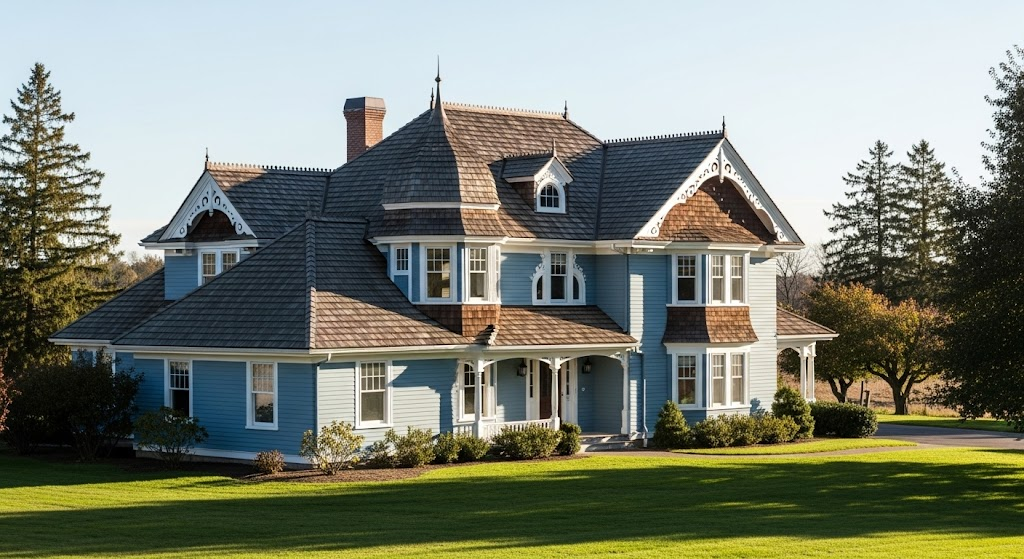
The total cost of replacing a roof can vary widely depending on several structural, material, and contractor-related variables. Below are the key factors that influence pricing.
1. Roof Size and Complexity
Larger roofs require more materials and labor, which increases the overall cost.
Complex roof shapes with multiple slopes, hips, valleys, and architectural features add difficulty.
These types of roofs take more time and skill to install, leading to higher labor charges and a longer project timeline.
2. Roof Accessibility
Roof access impacts how easily contractors can transport materials and equipment to the work area.
Obstructions like fences, trees, tight driveways, or steep landscaping can slow down the job.
More labor hours or specialized equipment may be required, which increases the final cost of the roof replacement project.
3. Number of Roof Penetrations
Penetrations such as chimneys, skylights, vents, and pipes complicate the roofing process.
Each penetration must be carefully flashed and sealed, increasing installation time and material usage.
Roofs with multiple features generally cost more to complete because they require precision work and additional labor.
4. Roof Pitch
Steeper roofs are more hazardous and require additional safety equipment such as harnesses or scaffolding.
The steeper the pitch, the slower the crew must work, which adds time and labor costs.
In some cases, extreme roof pitch may also necessitate specialized installation techniques or extra crew members.
6. Tear-Off and Disposal
Removing an old roof adds both time and expense to a replacement project.
The labor to tear off existing shingles, underlayment, and nails, along with the cost of dumpsters and landfill fees, can significantly increase the total cost.
Additional layers on the roof compound the effort and disposal requirements.
7. Decking Replacement
If the roof’s wooden decking is damaged, rotted, or soft, it must be replaced before the new roof can be installed. This adds both material and labor costs to the job.
Decking issues are often discovered during tear-off, making it a surprise expense in many roofing projects.
8. Roofing Components
A complete roofing system involves more than just shingles.
Components like underlayment, drip edge, flashing, ridge vents, starter strips, and ridge caps are essential for performance and durability.
These parts vary in quality and cost, and collectively they can make up a sizable portion of the overall budget.
9. Roofing Company Overhead
Every roofing company has overhead costs that are built into their pricing.
These can include insurance, licensing, office expenses, employee wages, equipment, and profit margins.
The more established or specialized the company, the higher their operating costs may be, which reflects in their quotes.
10. Labor Costs and Installation Factors
Labor makes up 40–60% of total roofing costs. Factors like roof design, timing, and the need for removal work all play a role in how much labor will cost.
Roof Complexity: Steep or multi-level roofs require extra safety gear and take longer to complete. Chimneys, skylights, and dormers increase labor by requiring careful detailing and slowing the overall pace of installation.
Tear-Off vs. Layover: Tearing off old shingles incurs an additional $1,000 to $2,500 in labor and disposal costs. Layovers are cheaper but may reduce performance and hide potential damage underneath the original roofing.
Time of Year: Roofing during peak seasons like summer often costs more. Scheduling work in cooler months, such as late fall, may offer better pricing, shorter wait times, and quicker job completion.
Material Choices and Their Impact on Cost
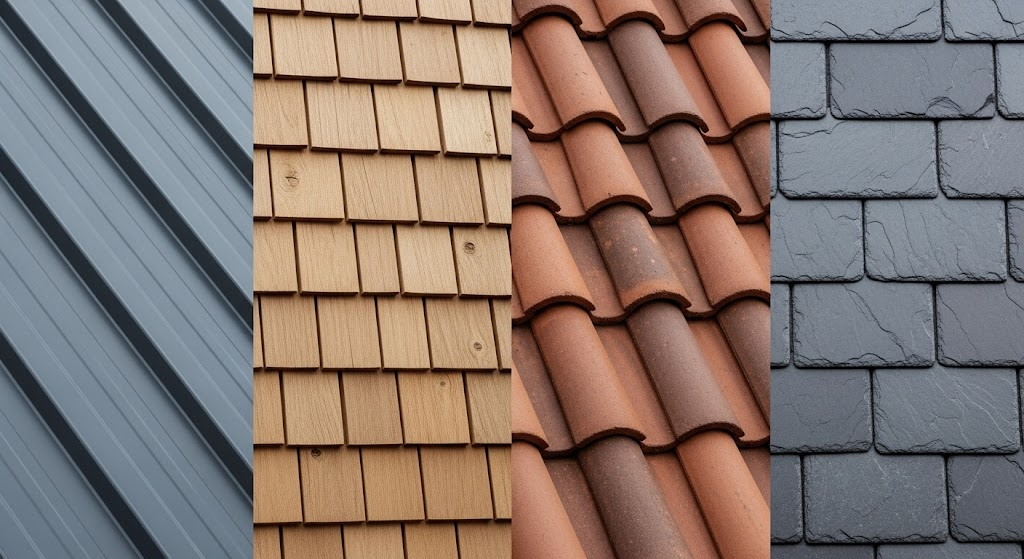
Choosing the right roofing material significantly affects overall cost, lifespan, and style. Below are six popular options, each with its own strengths and price range.
1. Asphalt Shingles
Asphalt shingles cost $100–$200 per square and are the most common roofing material. They’re affordable, easy to install, and last 15–30 years.
Available in many colors and styles, they offer good value for most homeowners and work well in a wide range of climates without requiring special structural support.
2. Metal Roofing
Metal roofs range from $300–$900 per square and last 40–70 years. They’re durable, fire-resistant, and great at shedding snow.
Though more expensive upfront, they require less maintenance over time and perform well in extreme weather conditions.
Metal is often used on modern homes or in regions with heavy snow or wildfire risks.
3. Wood Shakes or Shingles
Wood shakes or shingles cost $250–$600 per square. They provide a rustic, natural look that suits traditional-style homes.
However, they require regular maintenance and aren’t ideal for areas prone to wildfires.
Lifespan is shorter than other premium materials, making them better for homeowners who prioritize appearance over long-term durability.
4. Clay or Concrete Tile
Clay or concrete tiles cost $400–$1,000 per square. These heavy materials offer excellent durability and can last over 50 years.
They resist insects and rot but often require reinforced roof structures.
With a classic Mediterranean or Spanish look, tile roofs are ideal for hot, dry climates and add curb appeal to upscale homes.
5. Slate
Slate costs $800–$1,800 per square and is known for its elegance and longevity. A slate roof can last 100 years or more.
It’s heavy and requires expert installation, making it one of the most expensive options.
Best for luxury or historic homes, slate offers unmatched durability and a timeless appearance that few other materials match.
7. Synthetic Materials
Synthetic roofing materials cost $300–$600 per square and mimic natural options like slate or wood.
They’re lightweight, impact-resistant, and easier to install than their real counterparts.
Synthetic roofs offer a good balance of aesthetics, performance, and affordability.
With minimal maintenance and decent longevity, they work well for homeowners seeking modern solutions with a classic look.
Tear-Off vs. Roof-Over Costs
In roof replacement, homeowners choose between a tear-off, which removes the old roof, or a roof-over, which adds new shingles on top.
| Aspect | Tear-Off | Roof-Over |
|---|---|---|
| Cost | Higher ($1,000–$2,500 additional) | Lower initial cost |
| Labor | More labor-intensive | Faster, less labor required |
| Material Inspection | Full access to the decking and structure | Underlying issues may be hidden |
| Weight Load | Maintains structural limits | Adds extra weight to the roof structure |
| Durability | Optimal performance and lifespan | May reduce shingle life |
| Warranty | Typically retains the manufacturer’s warranty | May void warranty depending on brand and installer |
| Code Compliance | Always meets building codes | It may not be allowed in some regions |
What Permits, Inspections, and Warranties Really Cost?
Inspections may be needed to meet code requirements. Manufacturer warranties typically cover defects in shingles, while contractor warranties typically cover workmanship.
- Basic Warranty: Free or included in material cost.
- System Warranty: Adds $200–$500, often includes underlayment and accessories.
- Labor Warranty: May cost $300–$1,000, depending on the contractor.
Upgraded or extended warranties, especially those covering full systems, often require certified installers and may add several hundred dollars to the total project cost.
Extra Roofing Costs to Know About
When I planned my budget, I forgot to factor in several extras that added up quickly.
1. Underlayment and Flashing: These components sit underneath the visible roof to provide water protection. They cost an extra $1–$4 per square foot, depending on quality.
2. Ventilation: Proper ventilation keeps your attic cool and prevents moisture buildup. If your current vents aren’t up to code, expect to spend an additional $300–$600 on upgrades.
3. Permits and Inspections: Most cities require a permit for roofing projects, which can cost between $100 and $500. Some even mandate a post-installation inspection.
4. Cleanup and Disposal: Removing the old roof generates a significant amount of debris. A dumpster rental and disposal fee can range from $400 to $1,000, depending on your location and the amount of waste.
Should You DIY or Hire a Pro?
Below is a comparison of the main pros and cons of doing it yourself versus hiring a licensed professional:
| Pros of DIY | Cons of DIY |
|---|---|
| Can save 50% or more on labor costs | Dangerous without proper safety equipment |
| Full control over materials and timing | Extremely time-consuming for one person |
| Opportunity to learn and apply new skills | No warranty if the installation is incorrect |
My Final Costs and Takeaways
The table below outlines the full breakdown of what it costs to replace the roof on a 1,600-square-foot home:
| Item | Cost |
|---|---|
| Tear-off and disposal | $1,400 |
| Architectural shingles | $3,200 |
| Underlayment and flashing | $1,000 |
| Labor (2-day job) | $3,800 |
| Ventilation upgrades and permit fees | $600 |
| Warranties and final cleanup | $500 |
| Total | $10,500 |
Although the final price was more than anticipated, the investment brought lasting value, no more roof leaks, better energy efficiency year-round, and an increase in overall property value.
Tips for Saving on Roof Replacement
While it’s essential not to compromise on quality, there are ways to manage costs:
- Get Multiple Estimates: Obtain at least three quotes to compare prices and services.
- Schedule During Off-Peak Seasons: Roofing companies may offer discounts during slower periods.
- Choose Cost-Effective Materials: Architectural shingles offer a balance between cost and durability.
- Maintain Your Roof: Regular inspections and maintenance can extend your roof’s lifespan, delaying the need for replacement.
Conclusion
If you’re thinking about replacing your roof, I recommend starting with research, setting a realistic budget, and getting multiple quotes.
I’ve learned that it’s better to prepare for surprises like damaged decking or permit fees than to be caught off guard. I’d also budget an extra 10–15% just in case.
Picking the right materials, working with a licensed contractor, and understanding warranties can make a big difference in the outcome and lifespan of your new roof.
A roof isn’t just about protection; it’s a long-term investment in your home’s value and comfort.
If you still have questions or need help breaking down your options, feel free to reach out.
I’d be happy to help you take the next step toward a strong, lasting roof.

